India extends deadline of exemption in cotton import duty, what’s the purpose?
Since Mar, Indian cotton prices continue to hit record highs, and downstream textile industry faces lower profits. To curb the upward trend of cotton prices and ease the tight supply, Indian government announces to waive the import duty on cotton from Apr 14 to Sep 30. The deadline of end Sep is considered to be before the arrivals of new cotton and protect growers’ benefits. Since mid-Apr, according to USDA, the weekly export sales of U.S. upland cotton to India have climbed up apparently, but the cotton is mainly shipped till Jul and Aug. The removal of import duty in Apr has no quick effect on local cotton market.
In the meantime, under the high cotton prices, downstream textile profits keep deteriorating. Since Apr, Indian downstream spinning mills, non-governmental organizations and textile associations have lobbied the government for many times to extend the time limit for exemption in cotton import duty until the new crop is arrived and prohibit the export of cotton and cotton yarn. But there is no response from the government. In end Jun, the Minister of Textiles, Industry and Commerce said that it was unlikely to extend the time limit for exemption, but he also said later that the government would consider extending the tariff exemption for one month if the market situation was needed. Only a week later, on Jul 5, the Indian government announced to extend the exemption in cotton import duty till Oct 31. So what is the reason for the Indian government to change the idea? We believe that it is mainly due to the following considerations.
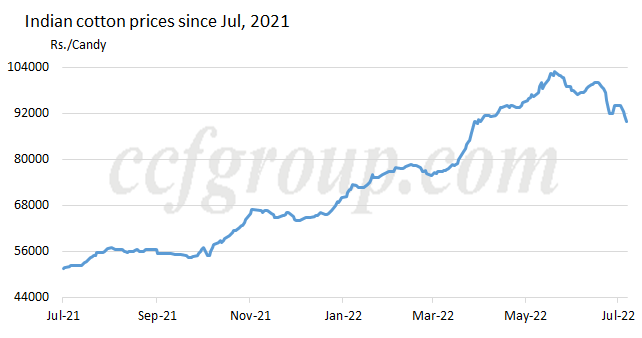
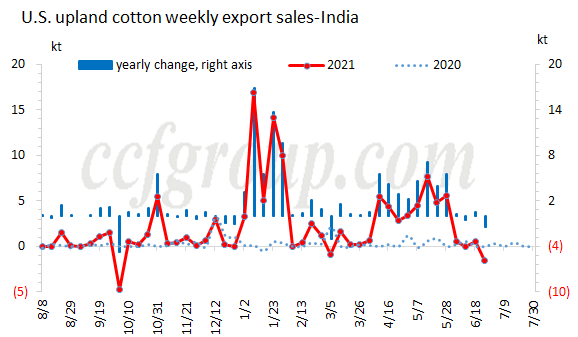
1. Arrivals of Indian cotton may be delayed this year
Looking from the weather condition, the monsoon rainfall in the major cotton producing areas comes slightly late in Jun. Besides, high temperature and dry weather is seen previously. Cotton sowing progress is slow in Maharashtra. According to the Department of Agriculture, the total area planted to cotton across the country advanced by over 1.25 million hectares in the week to June 24, to reach 3,183,300 hectares, 15 percent lower than at the same moment last year. Adequate monsoon rainfall comes till the third week of Jun, and then growers begin to plant intensively. Therefore, the intensive arrivals of 2022/23 cotton may be delayed by 2-3 weeks, to around mid or late Oct. If the exemption ends in end Sep, there may be supply gap, resulting into surging cotton prices and disturbing downstream plant operation.
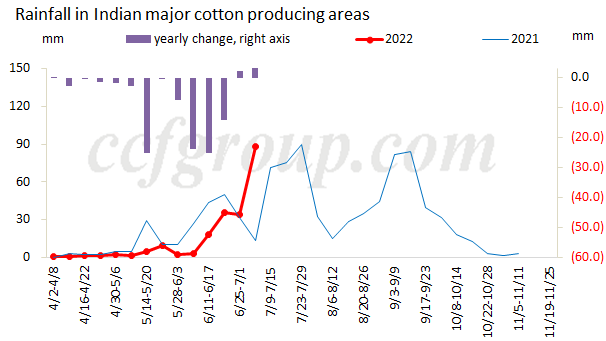
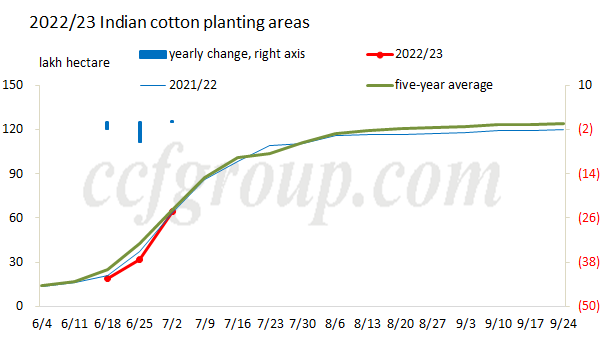
2. Indian cotton prices have not declined much during this round of sharp fall on global market
From Jun 21, global cotton prices start to decline, and Indian cotton prices also step lower, but its decrement is not large. As one of the most expensive cotton with Indian cotton, Brazilian cotton slip first, down from 170cent/lb in end May to 117cent/lb currently, with a decline of 31%, while Indian cotton starts to lower till Jun 21, with a decrement of 9.8%. After this round of sharp reduction on global market, Indian cotton becomes the most expensive cotton in the world, but its quality is not superior, so its competitiveness is weakening. With the anticipation of higher global cotton consumption in 2022/23 season, cotton prices for forward shipment are lower than that for nearby shipment, so to extend the exemption in cotton import duty is good for Indian spinners to purchase forward shipments and maintain long operation.
3. Orders in spinning mills weaken
Viewed from the Indian cotton yarn shipment, since Indian cotton prices hit the record high in Mar, the shipment date (from placing order to shipping) has been shortening, that is to say, under the high cotton costs, Indian spinners are hard to cut cotton yarn prices, and orders are deteriorating, with increasing inventory pressure. In addition, there is news about production cut of spinning mills, and strike to resist the high cotton prices. To extend the time limit of exemption will help ease the operation pressure.
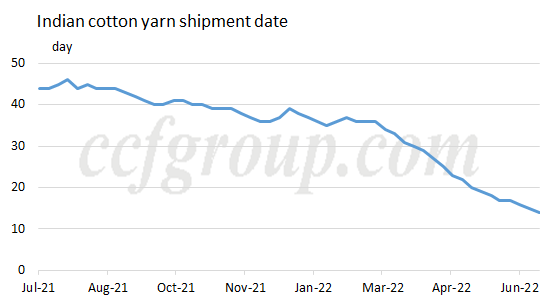
In general, the extension of exemption in cotton import duty is to regulate the cotton prices without influencing the growers’ benefits from new crops, and guarantee the steady production of downstream textile plants. To regulate cotton prices, Indian government can waive the import duty on cotton, encourage growers to plant new cotton and ensure production (to increase MSP) and ban the exports of cotton and cotton yarn. If Indian cotton planting areas or cotton crop growing condition are unfavorable, cotton prices may be hard to return to a rational price change, influencing the operation of textile industry, the government is likely to ban on cotton exports, as it has already announced to ban the wheat exports. But based on current Indian cotton planting condition, this action may be not likely to see.
Cotton prices slip following the lower general commodities amid the worries over the economic recession. Meanwhile, with the expectations of higher new cotton production, the supply tightness of global cotton is likely to ease later. This time of extension on cotton import duty exemption may not drive the global cotton prices up like mid-Apr.
- Top keywords
- Cotton Price
- Cotton Futures Price
- Cotton Futures
- CZCE
- PTA Futures Price
- Chemical Fiber
- Polyester Prices
- Wool price
- PTA Futures
- Shengze Silk
- China
- Yarn Price
- price
- China Textile City
- Fibre Price
- Benzene Price
- Cotton
- Index
- Cotton Index
- PTA
- fabric price
- NYMEX
- Top 10
- textile industry
- Spot Cotton
- Cotton Yarn
- Polyester Price
- Futures
- PTA Price
- cotton yarn price

